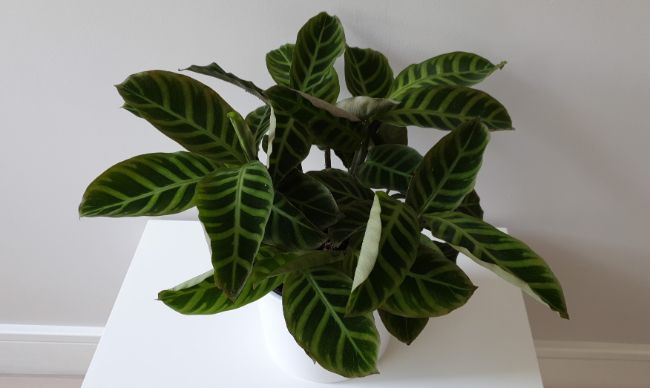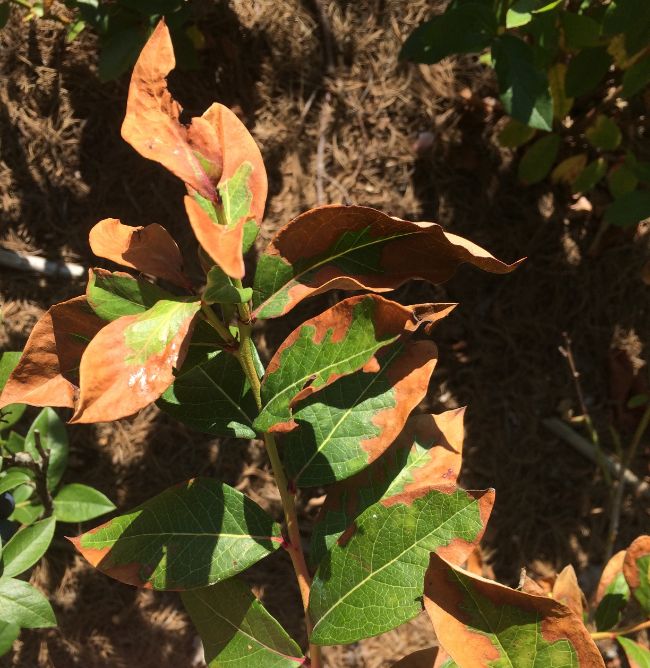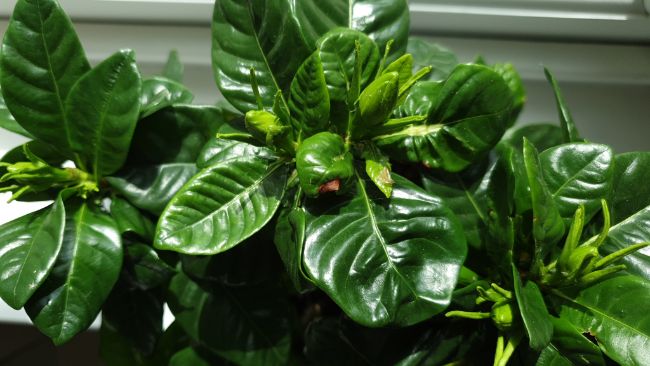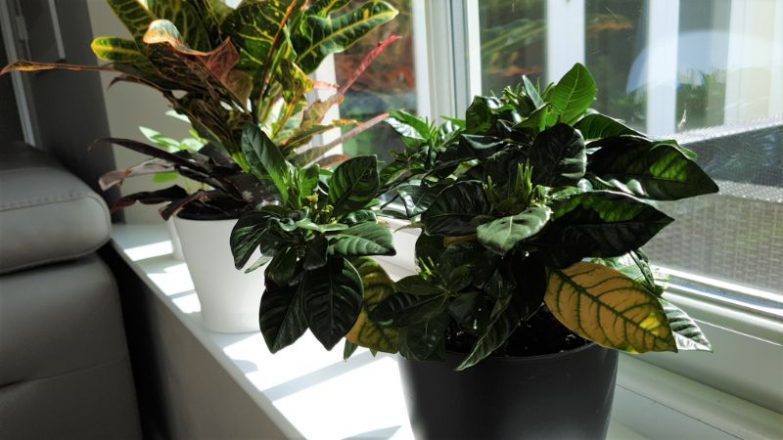We all want our plants to be healthy – but overfeeding does more harm than good. It’s important to know the common signs of overfeeding plants so you can fix the issue and avoid a worsening problem.
Signs Of Overfeeding Plants
- White fertilizer salt residue on the topsoil.
- Burned, brown leaf tips and edges.
- Yellow, curled, or wilting foliage.
- Deformed leaves.
- Loss of leaves, flowers, or fruit.
- Brown or black, rotting roots, or other signs of root damage.
- A lack of growth despite otherwise good care.
- Weak, spindly overgrowth of foliage.
- A lack of flowers.
Overview: The Signs Of Over Fertilizing
Two of the most common mistakes we make with plants are overwatering and overfertilization. It comes from the laudable motivation of giving our plants the best care possible … unfortunately, over-serving our plants can actually harm them.
Overfeeding plants is easy to do because the process is rather opaque and a plant’s nutritional consumption doesn’t correlate with our own. Fertilizer isn’t the same as food is to humans: plants create most of the nutrition they need through photosynthesis.
Why Over-fertilization Is So Easy To Do
Over-fertilization is common because plants don’t need as much as we tend to think they do. They only need the nutrients that photosynthesis doesn’t create … compared to animals, plants physically consume very little. Read this article for more information on how fertilizer works.
The problem can sneak up on you. Slow release or excess fertilizers can build up in the soil and become toxic to the plant over time. It can be confusing to see your plant develop a problem when you haven’t changed your routine.
It’s also easy to overlook overfertilization because its symptoms can be triggered by other causes. You must look deeper into the issue to make the right diagnosis.
Why Overfeeding Plants Is Harmful
Too much fertilizer does three bad things to plants: it strips needed moisture, poisons the soil, and opens them to stress-related disease and pest infestations.
- The salts contained in fertilizers can slow the flow of water into the roots and limit moisture levels in the foliage. Much of the damage caused by overfeeding shows up in the leaves.
- Excess fertilizer can inhibit biochemical reactions and destroy plant enzymes.
- The stress of overfeeding makes them susceptible to ailments … besides opportunistic infections, pests are attracted to weakened plants and can more easily establish an infestation.

Causes Of Overfertilization
The obvious case of overfeeding happens by administering too much fertilizer, but it can happen in other ways:
- Fertilizer from multiple applications that were never flushed from the soil can build up.
- Slow-release fertilizers are hard to gauge correctly and are easily overdosed.
- Poor drainage causes the soil to retain fertilizer residue.
- Dry conditions can limit the amount of fertilizer a plant uses.
- Maintaining a fertilizing routine when the plant goes dormant or the growing conditions change can lead to overfeeding.
If you’d like to learn how to prevent overfeeding your plants, read my guide to fertilizing houseplants to learn more.
Signs Of Overfeeding Plants
Overfertilization may manifest differently according to plant species and their environment. You may see several symptoms at once.
Each sign may also be caused by other factors such as overwatering, low light, etc. If your plant is showing symptoms, review the care you’ve been giving it.
If you’re not sure overfertilization is the source of a problem, a soil test can give you a more definite answer.
Crusted Deposits On The Topsoil
One of the clearest signs of overfeeding plants is the formation of a white or yellow crust on top of the soil. This residue represents an excess of fertilizer salts the plant hasn’t absorbed, and it can create toxic soil conditions if not addressed.
The problem is more likely to develop in a heavy mix that requires watering in small amounts to avoid puddling and sodden soil. It’s not often seen on open, fast-draining soil that is thoroughly drenched at watering time to flush the salts away. To make sure you’re using the right soil for your plants, read this article to learn more.
To help remedy the situation, remove the crusted deposits and water the plant thoroughly to rinse the soil. Consider repotting into a looser mix if drainage is an issue.
Burned Leaf Tips and Margins
This unsightly symptom can be caused by factors other than overfeeding – for example watering issues, low humidity, sunburn – but fertilizer burn happens rapidly. If your plant’s leaves develop brown tips or edges shortly after an application of fertilizer, you can be pretty sure of the culprit.
Plants with long or strap-like leaves are especially prone to this issue. Unfortunately there is no way to reverse the damage, but you can flush the soil and stop its progress. New foliage should grow healthily once the excess fertilizer has been cleared.

Leaf Yellowing And Wilting
Loss of moisture caused by overfeeding can cause the foliage to wilt or turn yellow. The lower leaves are often especially affected.
This is a rather vague symptom: besides overfertilization, it can also be caused by underwatering, root rot from overwatering, or lack of light. yellow leaves can result from undernutrition, too. Read my article about the causes of yellow leaves on houseplants to learn more.
Review the plant’s overall status and recent care before taking action – flushing the soil can alleviate wilting if the problem is too much fertilizer, but it could be deadly if the problem is root rot.
Deformed Leaves
Curled or otherwise misshapen leaves are common signs of overfeeding plants. It’s commonly seen when too much nitrogen has been applied.
This is another symptom that can be caused by other factors, namely overwatering, too much light, or a pest infestation. It’s best to spot the problem early when the tips are just beginning to curl. Flush the soil if you’re sure its overfertilization.
The deformed foliage won’t straighten back out, but the plant isn’t doomed. New growth will return to normal once the situation is remedied.
Limp, Browned Or Blackened Roots
So far we’ve dealt with symptoms that are fairly cosmetic and won’t endanger the plant if the problem is addressed, but root issues are more serious. The process that triggers foliage distress actually starts with the roots – and it can kill them.
In this case, we should go looking for trouble. Check the health of the root system by gently unpotting the plant and making sure the roots are firm and flexible. They shouldn’t have a foul odor. If they are black, limp, and smell of decay, your plant has root rot.
If there is only minor damage, you can cut the diseased roots away. Treatment is a bit tricky because rot pathogens thrive in moisture, so flushing the soil of fertilizer can exacerbate the problem.
If you’re sure the plant is suffering from being overfed, it might be necessary to flush the medium anyway; but dry out as quickly as possible. Consider leaving the plant out of the pot and/or using a fan.
Pro Tip: Some growers soak the soil with hydrogen peroxide to help kill rot pathogens. If you are forced to flush a toxic soil, finishing up with peroxide might be worthwhile.

Defoliation
Loss of foliage, flowers, or fruit can be signs of overfeeding plants. If this is the issue, it’s usually preceded by leaf damage … but some plants are easily triggered to drop their leaves from stress.
Almost any plant is more prone to leaf loss from overfertilization if it’s under other sources of stress. For this reason, it’s never a good idea to feed a plant right after a repot or relocation. Adding fertilizer to a sickly plant can end its troubles for good.
Treatment is the same as for any symptoms: remove visible fertilizer residue, flush the pot thoroughly and let it drain well. You’ll know the plant is on a comeback when you see new, healthy growth.
Slow or No Growth
If the plant is stalled and sits languishing in its pot, patience may not be the answer. The tricky part is that this symptom can be caused by either too little or too much fertilizer.
Of course, low light, cold weather, poor watering practices, or even being rootbound can also cause a plant to stall out in its pot, so rule these out too.
Review your recent fertilization schedule. If you’ve been fertilizing regularly, it might make sense to hold the servings and monitor the plant for a time.
If you decide the plant is undernourished, proceed carefully. If it’s growing season, apply the fertilizer at a quarter of the label’s recommendation and watch the plant’s reaction: it should perk up if that was the problem.
Rapid, Spindly Growth
Another way too much fertilizer can affect your plant is by stimulating it into producing thin, weak stems. This can be caused by too much nitrogen. (Of course, such legginess can also be due to insufficient light.)
Weak overgrowth is susceptible to pests and other problems. Sucking insects love to prey upon this kind of tender greenery.
Treat by flushing the soil, but consider giving the plant some extra light too. Some plants will recover better than others, but it’s probably a good idea to cut the spindly overgrowth back and let healthier material grow back.
Lack Of Flowers
Another symptom of a plant overloaded with nitrogen or other nutrients is a delay or absence of flowers or fruit. They are too busy producing foliage to settle down into the blossoming or fruit-setting phase.
Sometimes you can correct the direction by dosing the plant with a formula lower in nitrogen, but this requires guesswork. The safest solution is to simply flush the soil and use a balanced blend in the future.
Last Word
Over-fertilization is a much more common problem than under-fertilization, so always take a cautious approach when feeding your plants. Look for combinations of signs to help figure out whether overfeeding or another care issue is the source of the problem.
If you’d like to become an expert in houseplant care and be able to detect and fix common care issues easily, check out my book, Houseplants Made Easy. I cover every aspect of houseplant care to help you grow wonderfully healthy houseplants.

